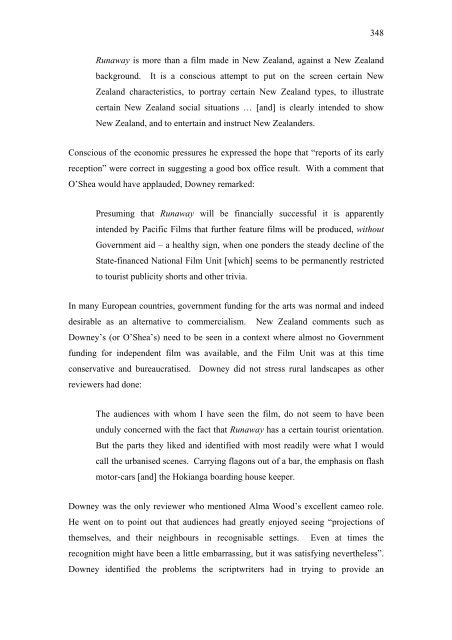Copyright Statement - ResearchSpace@Auckland
Copyright Statement - ResearchSpace@Auckland
Copyright Statement - ResearchSpace@Auckland
Create successful ePaper yourself
Turn your PDF publications into a flip-book with our unique Google optimized e-Paper software.
348<br />
Runaway is more than a film made in New Zealand, against a New Zealand<br />
background. It is a conscious attempt to put on the screen certain New<br />
Zealand characteristics, to portray certain New Zealand types, to illustrate<br />
certain New Zealand social situations … [and] is clearly intended to show<br />
New Zealand, and to entertain and instruct New Zealanders.<br />
Conscious of the economic pressures he expressed the hope that “reports of its early<br />
reception” were correct in suggesting a good box office result. With a comment that<br />
O’Shea would have applauded, Downey remarked:<br />
Presuming that Runaway will be financially successful it is apparently<br />
intended by Pacific Films that further feature films will be produced, without<br />
Government aid – a healthy sign, when one ponders the steady decline of the<br />
State-financed National Film Unit [which] seems to be permanently restricted<br />
to tourist publicity shorts and other trivia.<br />
In many European countries, government funding for the arts was normal and indeed<br />
desirable as an alternative to commercialism. New Zealand comments such as<br />
Downey’s (or O’Shea’s) need to be seen in a context where almost no Government<br />
funding for independent film was available, and the Film Unit was at this time<br />
conservative and bureaucratised. Downey did not stress rural landscapes as other<br />
reviewers had done:<br />
The audiences with whom I have seen the film, do not seem to have been<br />
unduly concerned with the fact that Runaway has a certain tourist orientation.<br />
But the parts they liked and identified with most readily were what I would<br />
call the urbanised scenes. Carrying flagons out of a bar, the emphasis on flash<br />
motor-cars [and] the Hokianga boarding house keeper.<br />
Downey was the only reviewer who mentioned Alma Wood’s excellent cameo role.<br />
He went on to point out that audiences had greatly enjoyed seeing “projections of<br />
themselves, and their neighbours in recognisable settings. Even at times the<br />
recognition might have been a little embarrassing, but it was satisfying nevertheless”.<br />
Downey identified the problems the scriptwriters had in trying to provide an















